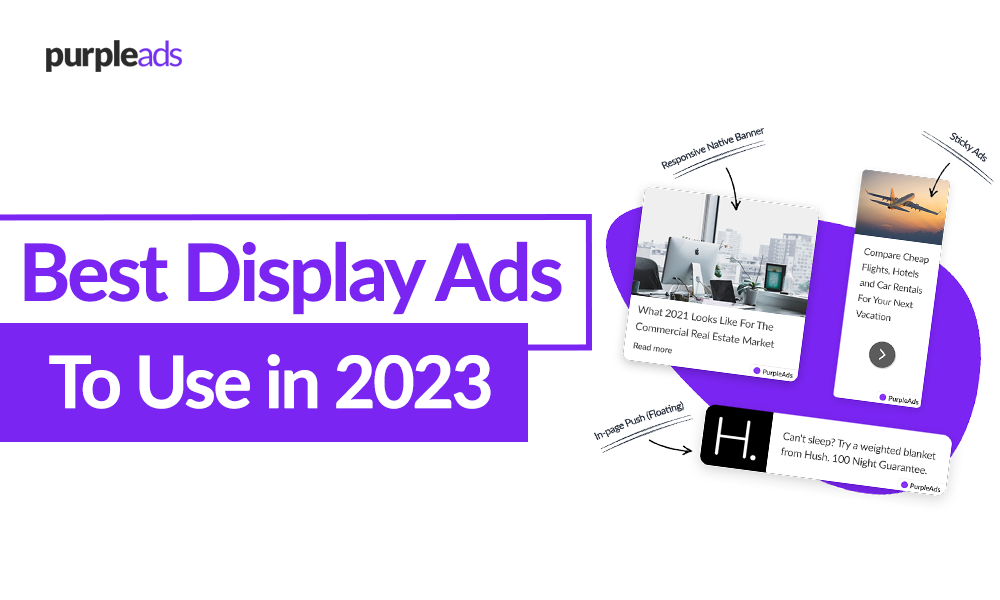Introduction to Display Ads
As a publisher or website owner, you are always looking for ways to monetize your online presence and generate revenue. One effective way to do this is through display advertising. Display ads are a form of online advertising that uses banner ads, text ads, and other visual elements to promote products or services on websites and other platforms.
In this blog post, we will explore the best types of display ads for publishers and website owners in 2023. We will discuss the pros and cons of each type of ad, as well as provide tips for effectively implementing them on your website.
Banner Ads
Banner ads are one of the most common types of display ads and have been around since the early days of the internet. These ads are typically placed at the top or bottom of a webpage and are often the first thing a visitor sees when they land on a site.
Pros:
- Wide reach: Banner ads can be seen by a large number of people, making them a great option for reaching a wide audience.
- Customizable: Banner ads can be customized to fit the look and feel of your website, making them a seamless addition to your site.
- Measurable: Many banner ad platforms offer detailed analytics and tracking tools, allowing you to see how well your ads are performing and make any necessary adjustments.
Cons:
- Low click-through rate: Despite their wide reach, banner ads often have a low click-through rate due to their reliance on visual appeal rather than compelling copy.
- Ad blocking: With the rise of ad blocking software, it is becoming increasingly difficult for banner ads to reach their intended audience.
Tips for implementation:
- Use clear, compelling copy: While banner ads rely heavily on visual appeal, the copy should still be clear and compelling to encourage clicks.
- Use eye-catching images: Use visually appealing images that are relevant to your ad’s message to capture the attention of your audience.
- Test different placements: Experiment with different placements for your banner ads to see which ones perform best.
Pop-Up Ads
Pop-up ads are a type of display ad that appears in a new window on top of the webpage a user is viewing. These ads can be triggered by a variety of actions, such as clicking on a link or entering a website.
Pros:
- High visibility: Pop-up ads are highly visible due to their placement on top of the webpage, making them hard to ignore.
- Targeted: Pop-up ads can be targeted to specific users based on their browsing habits and other factors, making them a more effective form of advertising.
Cons:
- Annoying to users: Many people find pop-up ads to be annoying and disruptive, leading to a negative perception of the advertiser.
- Blocked by ad blockers: Pop-up ads are often blocked by ad blockers, making it difficult to reach your intended audience.
Tips for implementation:
- Use sparingly: To avoid annoying your visitors, use pop-up ads sparingly and only when necessary.
- Offer value: Rather than using pop-up ads as a means of promoting products or services, consider using them to offer valuable content or information to your visitors.
- Use exit-intent technology: Exit-intent technology allows you to trigger a pop-up ad as a user is about to leave your site, increasing the chances that they will see it.
Native Ads
Native ads are a type of display ad that is designed to blend seamlessly into the content of a website. These ads are often presented in a format that is similar to the content surrounding them, making them less intrusive and more likely to be noticed by visitors.
Pros:
- High engagement: Native ads tend to have a higher engagement rate compared to other types of display ads, as they blend in with the surrounding content and are less likely to be ignored.
- Targeted: Like pop-up ads, native ads can be targeted to specific users based on their browsing habits and other factors.
Cons:
- Can be misleading: If not properly labeled, native ads can be misleading and give the impression that they are part of the editorial content rather than an advertisement.
- Limited in size and format: Native ads are typically limited in size and format, making it difficult to fit all of the necessary information in a small space.
Tips for implementation:
- Clearly label native ads as advertisements: It is important to clearly label native ads as advertisements to avoid misleading your visitors.
- Use relevant, high-quality content: To ensure that your native ads are effective, use relevant, high-quality content that is interesting and valuable to your audience.
- Experiment with different placements: Experiment with different placements for your native ads to see which ones perform best.
Conclusion
As a publisher or website owner, display advertising can be a valuable way to monetize your online presence and generate revenue. While all types of display ads have their pros and cons, it is important to choose the right one for your website and audience. By considering factors such as visibility, engagement, and targeting, you can choose the best type of display ad for your needs.

